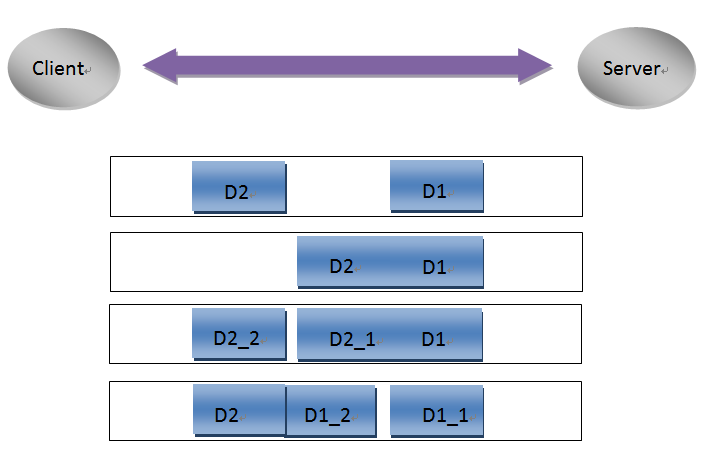tcp粘包拆包实例
更新日期:
1.TCP粘包/拆包
TCP是个”流”协议,所谓流,就是没有界限的一串数据。大家可以想想河里的水,是连成一片的,其间并没有分界线。TCP底层并不了解上层业务数据的具体含义,它会根据TCP缓冲区的实际情况进行包的划分,所以在业务上认为,一个完整的包可能被TCP拆分成多个包进行发送,也有可能把多个小的包封装成一个大的数据包发送,这就是所谓的TCP粘包和拆包问题。
2.TCP粘包拆包问题说明
通过下图进行说明:

假设客户端分别发送了两个数据包D1和D2给服务端,由于服务端一次读取的字节数是不确定的,所以可能存在以下四种情况。
- 服务端分两次读取了两个独立的数据包,分别是D1和D2,没有粘包和拆包。
- 服务端一次读取到了两个数据包,D1和D2粘合在一起,被称为TCP粘包。
- 服务端分两次读取到了两个数据包,第一次读取了完整的D1包和D2包的部分内容,第二次读取到了D2包的剩余内容,这被称为TCP拆包。
- 服务端分两次读取到了两个数据包,第一次读取了D1包的部分内容D1_1,第二次读取了D1的剩余内容D1_2和D2包的整包。
如果此时tcp接收滑窗非常小,而数据包D1和D2比较大。很有可能发生第五种情况,即服务端分多次才能将D1和D2包接收完全。
3.TCP粘包拆包发生的原因
问题产生的原因有三个,分别如下:
- 应用程序写入的字节大小大于套接口发送缓冲区大小。
- 进行MSS大小的TCP分段。
- 以太网侦测的payload大于MTU进行IP分片。
图示:
4.粘包问题的解决策略
由于底层的TCP无法理解上层的业务数据,所以在底层是无法保证数据包不被拆分和重组的,这个问题只能通过上层的应用协议栈设计来解决,根据业界的主流协议的解决方案如下:
- 消息定长,例如每个报文的大小固定长度为200字节,如果不够,空位补空格。
- 在包尾增加回车换行符进行分割,例如FTP协议。
- 将消息分为消息头和消息体,消息头包含表示消息体总长度的字段,通常设计思路为消息头的第一个字段使用int32来表示消息的总长度。
- 更复杂的应用层协议。
5.实例代码
服务器端代码
public class TimeServer {
public void bind(int port) throws Exception {
EventLoopGroup bossGroup = new NioEventLoopGroup();
EventLoopGroup workderGroup = new NioEventLoopGroup();
ServerBootstrap b = new ServerBootstrap();
try {
b.group(bossGroup, workderGroup).channel(NioServerSocketChannel.class)
.option(ChannelOption.SO_BACKLOG, 1024).childHandler(new ChildChannelHandler());
// 绑定端口,同步等待成功
ChannelFuture f = b.bind(port).sync();
// 等待服务器端端口关闭
f.channel().closeFuture().sync();
} finally {
bossGroup.shutdownGracefully();
workderGroup.shutdownGracefully();
}
}
private class ChildChannelHandler extends ChannelInitializer<SocketChannel> {
protected void initChannel(SocketChannel channel) throws Exception {
channel.pipeline().addLast(new LineBasedFrameDecoder(1024));
channel.pipeline().addLast(new StringDecoder());
channel.pipeline().addLast(new TimeServerHandler());
}
}
public static void main(String[] args) throws Exception {
int port = 8888;
if (args.length > 0) {
try {
port = Integer.valueOf(args[0]);
} catch (NumberFormatException e) {
e.printStackTrace();
}
}
new TimeServer().bind(port);
}
}
服务器端handler
public class TimeServerHandler extends ChannelHandlerAdapter {
private int counter;
public void channelRead(ChannelHandlerContext ctx, Object msg) throws Exception {
String body = (String) msg;
System.out.println("The time server receive order :" + body + " ; the counter is :" + ++counter);
String currentTime = "QUERY TIME ORDER".equalsIgnoreCase(body) ? new java.util.Date(System.currentTimeMillis())
.toString() : "BAD ORDER";
currentTime += System.getProperty("line.separator");
ByteBuf resp = Unpooled.copiedBuffer(currentTime.getBytes());
ctx.write(resp);
}
public void channelReadComplete(ChannelHandlerContext ctx) throws Exception {
ctx.flush();
}
public void exceptionCaught(ChannelHandlerContext ctx, Throwable cause) throws Exception {
ctx.close();
}
}
客户端代码
public class TimeClient {
public void connect(int port, String host) {
// 配置客户端NIO线程组
EventLoopGroup group = new NioEventLoopGroup();
Bootstrap bootstrap = new Bootstrap();
try {
bootstrap.group(group).channel(NioSocketChannel.class).option(ChannelOption.TCP_NODELAY, true)
.handler(new ChannelInitializer<SocketChannel>() {
protected void initChannel(SocketChannel ch) throws Exception {
ch.pipeline().addLast(new LineBasedFrameDecoder(1024));
ch.pipeline().addLast(new StringDecoder());
ch.pipeline().addLast(new TimeClientHandler());
}
});
// 发起异步连接操作
ChannelFuture f = bootstrap.connect(host, port).sync();
// 等待客户端链路关闭
f.channel().closeFuture().sync();
} catch (InterruptedException e) {
e.printStackTrace();
} finally {
group.shutdownGracefully();
}
}
public static void main(String[] args) {
int port = 8888;
try {
if (args.length > 0) {
port = Integer.valueOf(args[0]);
}
} catch (NumberFormatException e) {
e.printStackTrace();
}
new TimeClient().connect(port, "127.0.0.1");
}
}
客户端handler
public class TimeClientHandler extends ChannelHandlerAdapter {
private int counter;
private byte[] req;
public TimeClientHandler() {
req = ("QUERY TIME ORDER" + System.getProperty("line.separator")).getBytes();
}
public void channelActive(ChannelHandlerContext ctx) throws Exception {
ByteBuf message = null;
for (int i = 0; i < 100; i++) {
message = Unpooled.buffer(req.length);
message.writeBytes(req);
ctx.writeAndFlush(message);
}
}
public void channelRead(ChannelHandlerContext ctx, Object msg) throws Exception {
String body = (String) msg;
System.out.println("Now is :" + body + " ; the counter is : " + ++counter);
}
public void exceptionCaught(ChannelHandlerContext ctx, Throwable cause) throws Exception {
ctx.close();
}
}